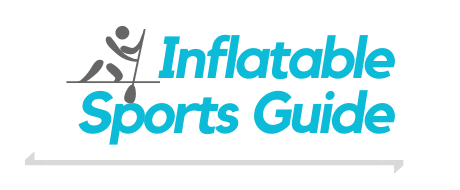Buying an inflatable SUP may come across as a trivial task for most people. However, the sheer number of options could make buying an inflatable paddleboard, especially for beginners, an absolute nightmare.
Since paddleboarding is one of the rapidly growing watersports, it’s expected that new companies with almost zero reputation are trying to get their market share by making cheap boards targeted at beginners.
As a result, the market is jam-packed with inexpensive paddleboards from new brands that may seem very tempting for newcomers but are often not an excellent long-term investment.
In this article, we’ll guide you through the decision-making process to help you make a more informed decision on buying an inflatable SUP that is suitable for you.
Let’s get started.

Buying Your First Inflatable SUP: What to Do
These are the six things you need to do before buying your first inflatable SUP.
Set your budget
In the world of inflatable boats, you will often get your money’s worth with every purchase. In other words, the more you spend on an inflatable SUP, the better quality and durability you’ll get out of it.
But not everyone wants to spend $1,000 on a paddleboard that they may only use twice a year during the summer.
That’s why it’s essential to set your budget before taking a look at the available options. As mentioned earlier, there are hundreds of inflatable paddleboard models available in the market right now.
Setting your budget early on can help you narrow down the choices and pick the best of the bunch that can give you the most value.
Pick a beginner-friendly board
Your first inflatable paddleboard should be something that will help you learn how to get around on the water and get comfortable with your environment at your own pace.
The best choice would be an all-rounder inflatable paddleboard suitable for various situations and use cases. All-rounder boards also have the stability and comfort that every beginner will be thankful to have on their first trip in the water.
It’s also good to know where you will be using your paddleboard. If you’re planning to paddle primarily in flatwater conditions like a lake, pond, or bay, your typical all-rounder boat like the iRocker All-Round Paddleboard should be more than enough to get you started.
If you’re going to paddle around a more wavy area, it’s best to go for the surfboard design with three fins to help you stay stable even on rough waters.
The general rule of thumb when picking out your first inflatable paddleboard is: the wider the board, the more stable it is on the water. If you’re completely new to the watersport hobby, you should stick to all-rounder boards.
Try to get a complete package
Once you’ve decided on your budget and where you’ll be using your first paddleboard, the next thing you should consider in buying an inflatable SUP is finding an all-in offer. The last thing you want to do is getting excited to get on the water only to find out that you don’t have the pump to inflate your paddleboard.
Some of the best paddleboards under $400 offers a complete selling package with everything you need to get on the water, which includes:
- Paddleboard
- Paddle
- Carrying bag
- Inflation pump
- Repair patch kit
- Personal flotation device
Several brands also offer additional removable and interchangeable fins to help your board perform better in different scenarios.

Materials and construction
There are different types of materials and construction methods involved in making an inflatable stand-up paddleboard. Generally, the materials and construction methods will follow your budget—the more you spend, the better you get.
The three types of paddleboards constructions are:
- Single-layer: Paddleboards in this category are made with a pair of thin sheets joined together with thousands of threads (known as drop-stitch fabric) with a thin coat of PVC to add the air-tight property. Boards with this construction are typically inexpensive and have less durability, but more than enough to get started on flatwater conditions.
- Fusion: Paddleboards made with this construction have 2-ply fabric sheets joined together by thousands of threads. The result is a more rigid paddleboard with more puncture resistance, durability, and stability.
- Dual-layer: Paddleboards with dual layers are typically those of high-end quality and cost. In a dual-layer construction, multiple adhesive and PVC coating protects the board and improves its rigidity.
Check for portability
One of the perks of having an inflatable paddleboard instead of a hardshell one is its portability. You can simply deflate your paddleboard and fold it up nicely into a carrying bag when not in use.
Typical inflatable paddleboards are very light at 17-22 pounds when fully inflated. Although they are lightweight, you should look for a model that has a carrying handle. Otherwise, it would be somewhat annoying to wrap your arms around the paddleboard or carry it over your head.
Carrying handles are typically molded into the board or recessed so they won’t get in the way while you’re out and about paddling.
Prioritize safety and comfort
The general guidelines in buying an inflatable SUP that is comfortable are picking a rated model to support your weight and has a comfortable deck pad material.
Most all-rounder inflatable paddleboards can carry up to 350 pounds of weight with ease. But you should always double-check the carrying capacity with the board’s volume, which is often measured in liters. A good rule of thumb to follow is doubling your weight—if you’re 160 pounds (roughly 72 kgs), you should look for a paddleboard with at least 144 liters volume.
It’s also important to select the best deck pad material and design. If you’re browsing for an inflatable SUP online, it may be hard to observe the material, texture, comfort, and grip of its deck pad.
If you’re planning on spending some time paddling your board, make sure to pick the one with a thick and patterned deck pad to get the best comfort and prevent you from slipping.

Conclusion
While there are other factors that you should consider, like brand reputation, recommendation, and reviews, these six steps to buying your first inflatable SUP can speed up your selection process.
Picking the best option could be a challenge especially for a first-time buyer, but we genuinely hope that our beginner’s guide to buying an inflatable SUP helps you narrow down your choices.
Related Posts
- Finding the Best Inflatable SUP For Beginners
Finding the best inflatable SUP for beginners can be challenging due to the overwhelming amount…
- 10 Things to Consider Before Buying an Inflatable SUP
If you're thinking about getting an inflatable stand-up paddle board, and you're having a hard…
- Best Inflatable Paddle Boards Under $400
Inflatable paddle boards can come in a wide range of prices, and today we're going…
